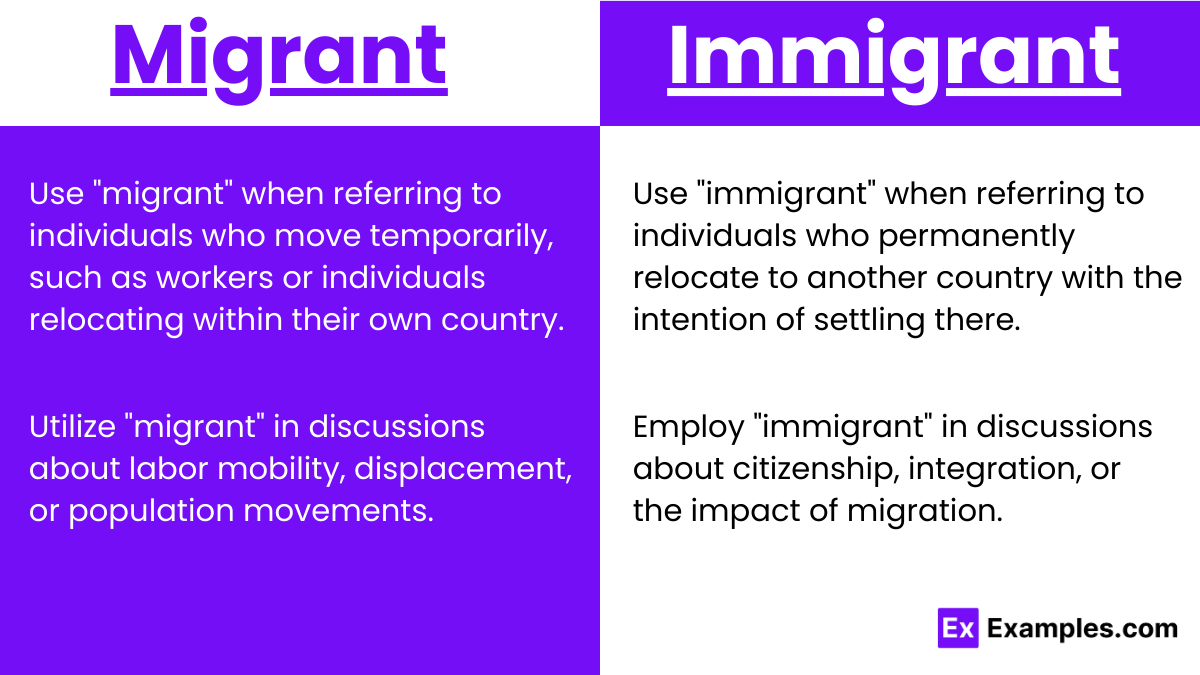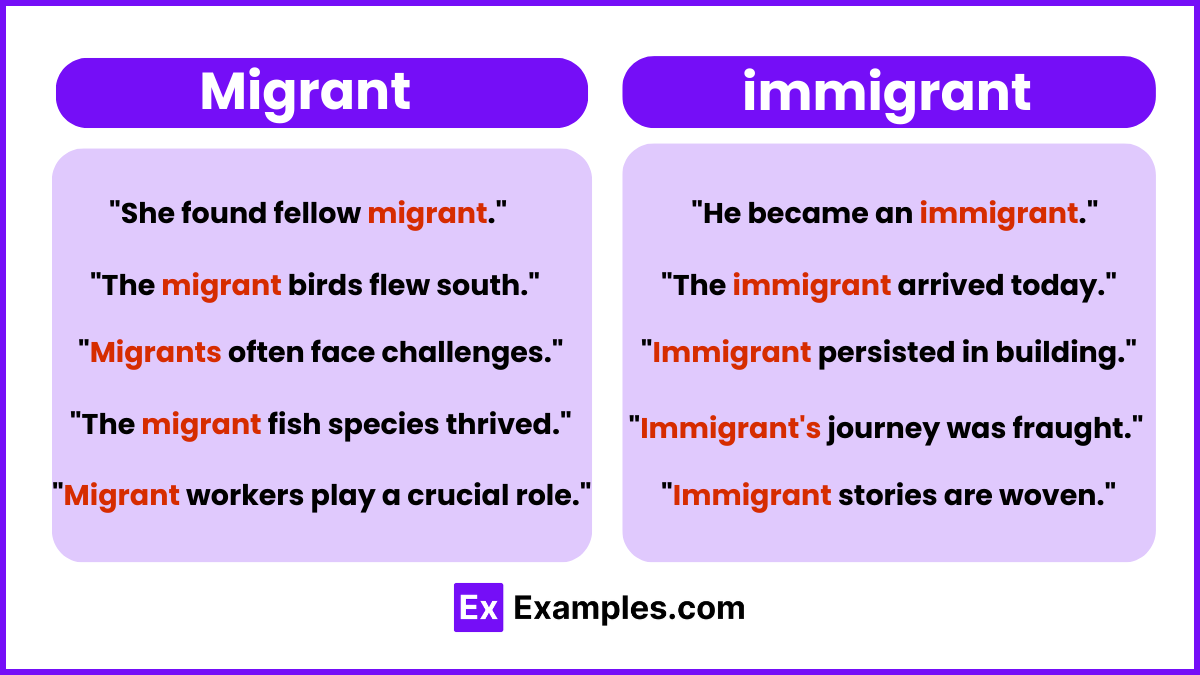Migrant vs Immigrant – Meanings, Difference, Usage, Examples
In everyday conversations and news reports, you might hear the terms “migrant” and “immigrant” used interchangeably. However, they carry distinct meanings that are crucial to understand. At their core, both words refer to individuals seeking better opportunities or safety in a new place. Whether they’re leaving their homeland for a job, education, safety from danger, or to reunite with loved ones, migrants and immigrants are real people with hopes and dreams. Let’s delve into the differences between these two terms and why grasping their distinctions is vital.
Migrant and Immigrant – Meanings
“Migrant” and “Immigrant” are nouns used to describe individuals who move from one place to another, but they connote different aspects of the migratory process.
- Migrant: A migrant refers to a person who moves from one place to another, often within a country or across borders, with the intention of settling temporarily or permanently in the new location.
- Immigrant: An immigrant is an individual who permanently relocates from one country to another with the intention of residing there for an extended period, if not indefinitely. Immigrants typically undergo legal procedures to enter and establish themselves in the new country, which may involve obtaining visas, residency permits, or citizenship.
Summary
Migrants and Immigrants are often confused, but they’re different. Migrants move from one place to another, either within their own country or to another country, for various reasons like work or seeking a better life. Immigrants, on the other hand, are people who permanently move to a new country to live there. So, migrants could be immigrants, but not all migrants become immigrants. Think of migrants as people who move around, while immigrants are those who settle in a new country for good.
How to Pronounce Migrant and Immigrant
Migrant: Pronounced as /ˈmaɪɡrənt/ (MY-gruhnt).
Immigrant: Pronounced as /ˈɪmɪɡrənt/ (IM-i-gruhnt).
Differences between Migrant and Immigrant
| Aspect | Migrant | Immigrant |
|---|---|---|
| Duration | Temporary | Permanent |
| Purpose | Various (e.g., work, refuge) | Settlement in another country |
| Legal Status | May include undocumented | Typically undergoes legal processes |
| Scope | Broad | Specific to international relocation |
| Movement | Within or between countries | Crossing international borders |
How to Remember the Difference between Migrant and Immigrant
- Think of “migrant” as encompassing various temporary movements, as it contains the word “migrate,” indicating movement from one place to another.
- “Immigrant” implies permanent settlement in another country, akin to “immersion” in a new culture or society.
When to Use Migrant and Immigrant

Usage of Migrant
- Use “migrant” when referring to individuals who move temporarily, such as seasonal workers, refugees, or individuals relocating within their own country.
- Utilize “migrant” in discussions about labor mobility, displacement, or population movements influenced by economic, social, or environmental factors.
Usage of Immigrant
- Use “immigrant” when referring to individuals who permanently relocate to another country with the intention of settling there.
- Employ “immigrant” in discussions about citizenship, integration, or the impact of migration on destination countries’ demographics and cultures.
Migrant and Immigrant – Examples

Migrant Examples
- Many agricultural industries rely on migrant workers to harvest crops during peak seasons.
- The refugee crisis has led to a significant influx of migrants seeking asylum in neighboring countries.
- Internal migrants often move from rural areas to urban centers in search of better employment opportunities.
Immigrant Examples
- She immigrated to the United States from Mexico in search of a better life for her family.
- The country’s immigration policy aims to attract skilled immigrants to contribute to its economic development.
- Immigrants play a vital role in enriching the cultural fabric of their adopted countries.
Synonyms
| Migrant Terms | Immigrant Terms |
|---|---|
| Traveler | Settler |
| Nomad | Newcomer |
| Sojourner | Resident |
| Transient | Transplant |
| Visitor | Incomer |
Exercise
- They provided shelter for __________.
- She became an __________ last year.
- __________ moved to a new country for better opportunities.
- He is a seasonal __________.
- __________ are an integral part of multicultural societies.
Answers
- migrants
- immigrant
- She
- migrant
- Immigrant
FAQ’S
What is the difference between immigration and migration?
Immigration involves settling permanently in a new country, while migration is the movement of people within or across borders, often temporary.
Is a migrant the same as a refugee?
No, a migrant moves voluntarily for various reasons, while a refugee flees persecution, seeking safety and international protection.
Who is considered a migrant?
Anyone relocating temporarily or permanently within or across borders for better opportunities, work, education, or lifestyle changes is considered a migrant.
Is a US citizen an immigrant?
Not necessarily. A US citizen may be born abroad or have immigrated, but not all citizens are immigrants.
What states have the most immigrants?
California, Texas, Florida, and New York have the highest immigrant populations in the US, contributing diverse cultures and economies.
Who is a U.S. non-immigrant?
A U.S. non-immigrant is a temporary visitor, such as tourists, students, or temporary workers, allowed to stay for a specific period under designated visa


